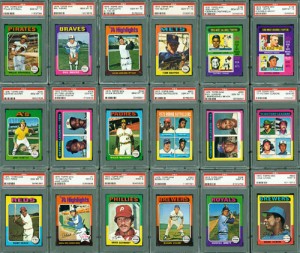
PSA is really considered the grandfather of grading, although the concept of encapsulation is still a relatively new concept considering the long history of trading cards. The famous T206 Honus Wagner card was graded “8” by PSA to launch the service. PSA graded cards are common in the hobby because the company grades thousands each week covering every era that sports cards have been produced.
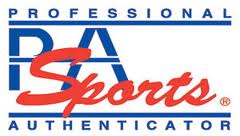 PSA also does a tremendous volume of grading for autographs, tickets, bats and other items. A subsidiary of Collectors Universe, the southern California-based company is a regular at major sports card shows across North America.
PSA also does a tremendous volume of grading for autographs, tickets, bats and other items. A subsidiary of Collectors Universe, the southern California-based company is a regular at major sports card shows across North America.
You can find PSA labels on everything from the earliest cards produced in the 19th century to the latest hot rookie autograph card pulled from a pack.
Its “Set Registry” enables collectors build sets of PSA authenticated baseball cards and compare them to others who are doing the same thing. An organizational tool, it lets you know at a glance what you have, the grade of each card and an average grade for your partial or completed set.
The PSA “Population Report” lists each card that PSA has ever graded, the total number of cards graded and how many have been assigned to each specific numerical 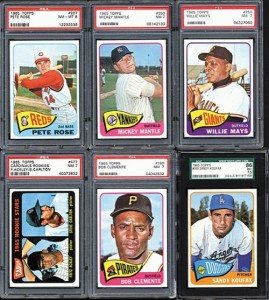 grade. It’s how to determine which cards are the hardest to find in high grade. Prices for graded sports card auctions will often reflect what the pop report says. Since many collectors break their cards out of holders for a wide variety of reasons, the pop report is never 100% accurate but it’s a pretty good barometer used by most collectors of PSA graded baseball cards.
grade. It’s how to determine which cards are the hardest to find in high grade. Prices for graded sports card auctions will often reflect what the pop report says. Since many collectors break their cards out of holders for a wide variety of reasons, the pop report is never 100% accurate but it’s a pretty good barometer used by most collectors of PSA graded baseball cards.
PSA has introduced a variety of different holders to accommodate the various sizes of vintage sports cards, from Turkey Red cabinets to Exhibit cards and Topps Supers.
Here’s an overview of the PSA grading standards:
GEM-MT 10: Gem Mint A practically flawless card is considered a PSA Gem Mint 10. Attributes include four perfectly sharp corners, sharp focus and full original gloss. A Gem Mint 10 card does not have any stains. Allowances are made in the case of slight printing imperfections so long as it doesn’t impede the card’s general appeal. The image must be centered within a tolerance of 55/45 to 60/40 percent on the front, and 75/25 percent on back.
MINT 9: Mint A superb card with only one of these minor flaws: a very slight wax stain on reverse, a minor printing imperfection or slightly off-white borders. Centering must be approximately 60/40 to 65/35 or better on the front and 90/10 or better on the reverse.
NM-MT 8: Near Mint-Mint A high-end card that can exhibit the following upon close inspection: a very slight wax stain on reverse, slightest fraying at one or two corners, a minor printing imperfection, and/or slightly off-white borders. Centering must be approximately 65/35 to 70/30 or better on the front and 90/10 or better on the reverse.
NM 7: Near Mint A card with a slight surface wear visible under close inspection. Corners could have slight fraying and the picture focus may be slightly out-of-register. A minor printing blemish and slight wax staining on the back of the card is acceptable. Centering must be approximately 70/30 to 75/25 or better on the front and 90/10 or better on the back.
EX-MT 6: Excellent-Mint This card may have visible surface wear or a minor printing defect non-inhibitive to it’s appeal. Other factors contributing to this grade may be: a very light scratch, slightly graduated fraying of the corners, “out-of-register” picture focus, loss of original gloss, a minor wax stain on reverse, slight notching on edges and some off-whiteness on borders. Centering must be 80/20 or better on the front and 90/10 or better on the back.
EX 5: Excellent These cards may exhibit very minor rounding of the corners and surface wear is visible. There may be diminished gloss and minor chipping on the edges. The picture could be out of focus and close inspection may reveal light scratches that don’t diminish the card’s appeal. Centering must be 85/15 or better on the front and 90/10 or better on the back.
VG-EX 4: Very Good-Excellent These cards may have slightly rounded corners, noticeable but modest surface wear with some original gloss. Light scuffing or scratches could be evident. Borders could be slightly off-white and there may be a light crease. Centering must be 85/15 or better on the front and 90/10 or better on the back.
VG 3: Very Good
These cards reveal rounding on the corners, though not extreme. Surface wear, light scuffing or scratches are apparent. Noticeable wear on the edges 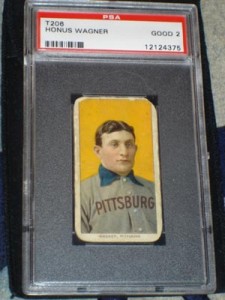 and off-register focus are apparent. Most of the card’s original gloss will be gone. Somewhat yellowed and/or discolored borders, a visible crease and printing defects are possible. Centering must be 90/10 or better on the front and back.
and off-register focus are apparent. Most of the card’s original gloss will be gone. Somewhat yellowed and/or discolored borders, a visible crease and printing defects are possible. Centering must be 90/10 or better on the front and back.
GOOD 2: Good These cards show accelerated rounding on the corners and obvious surface wear. There may be scratching, scuffing, light staining, or chipping of enamel on obverse. Several creases, loss of the original gloss and considerable discoloration are apparent. Centering must be 90/10 or better on the front and back.
FR 1.5: Fair These cards show extreme wear (including scuffing, scratching, pitting, chipping and staining), and may affect the framing of the picture. Brown and dirty borders, out-of-register picture, heavy creases but fully intact (not missing solid pieces of the card due to major tears, etc…) despite heavy wear. This includes the back layer of the card and entire corners. The centering must be approximately 90/10 or better on the front and back.
PR 1: Poor These cards exhibit much of the same damage as in a PSA Fair 1.5, only the damage has advanced to a stage that the card’s visible appeal has all but vanished. It may be missing small pieces, and the creasing nearly breaks through the layers of cardboard. It may contain extreme discoloration and/or dirtiness making it difficult to read or identify content on the card, front and back. It may contain warping or other types of destructive defects.
Half-Point Grades:
Cards with high-end qualities between PSA Good 2 and PSA Mint 9 could get a half-point increase. All attributes will be graded and there will be a clear focus on centering.
A card must be 5-10% better centered than the lowest percent allowed within a grade. The overall strength of the card such as the corners or print could give the card the edge it needs in spite of marginal centering. Qualifiers will not apply to grades that achieve the half-point increase.
QUALIFIERS:
Nearly every card submitted to PSA will be graded. Those containing significant flaws will get “qualified” grades as follows:
OC (Off Center): An “OC” designation is for cards where the centering falls below the minimum standard for that grade. This is done by comparing the measurements of the borders from left to right and top to bottom. The centering is designated as the percent of difference at the most off-center part of the card. A 5% grace is given to the front centering minimum standards for cards which grade NM 7 or better. For example, a card that meets all of the other requirements for PSA MINT 9 and measures 60/40 off-center on the front automatically meets the PSA front centering standards for MINT 9. If a card meets all of the other requirements for PSA MINT 9 and measures 65/35 off-center on the front, it may be deemed to meet the PSA front centering standards for MINT 9 if the eye appeal of the card is good.
ST (Staining): Designated for cards with staining below the minimum standards for the grade.
PD (Print Defect): Designated for cards with significant printing defects.
OF (Out of Focus): Designated for cards with focus below the minimum standards for the grade.
MK (Marks): Designated for cards with writing, ink marks, pencil marks (etc…) or evidence of the impression left from the act of writing.
MC (Miscut): Designated for cards that exhibit an atypical cut for the issue or ones that contain partial portions of more than one card.
UNGRADEABLE CARDS: Cards that bear evidence of trimming, re-coloring, restoration, or any other forms of tampering, or are of questionable authenticity will not be graded. PSA also does not grade autographed cards dated earlier than 1998 or any cards manufactured by Star except Star Baseball and 1996 Star Topps (reprint) Basketball Cards; only factory imprint signatures can be graded.
The Grading of Hand-Cut Cards
Any card that has been hand-cut off a panel, box, or others (Post Cereal, Hostess, Bazooka, Strip cards, etc…) can be graded by PSA. This service excludes traditional sheet-cut cards. PSA will not grade cards cut from sheets that can be obtained in a normal fashion.
PSA only assigns grades to cards with clearly defined borders. There must be visible/defined border on all four sides. Cuts that exceed the visible border will be encapsulated as “Authentic” only. Undersized cards that suffer in general eye appeal may be rejected by PSA graders and deemed unsuitable for authentication.
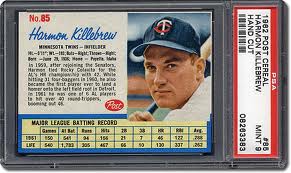 A size requirement is till required for all cards, even without visible/defined borders to be graded. Without full borders, a label of “Authentic” will be assigned. PSA will also allow cards that have had coupons or tabs removed from the original card. All cards eligible for this service will be designated as “Hand-Cut” on the PSA label to distinguish them from the intact, “with tab” or “with coupon” examples. They strive to maintain consistency in their guidelines for authentication.
A size requirement is till required for all cards, even without visible/defined borders to be graded. Without full borders, a label of “Authentic” will be assigned. PSA will also allow cards that have had coupons or tabs removed from the original card. All cards eligible for this service will be designated as “Hand-Cut” on the PSA label to distinguish them from the intact, “with tab” or “with coupon” examples. They strive to maintain consistency in their guidelines for authentication.
The highest grades in this category are achieved with cuts that are relatively close to the visible borders without exceeding the limit. Those that exhibit a clean, accurate and properly shaped cut have the best chance of obtaining the highest grade. General eye appeal is key. Excess paper or cardboard around the edges of the visible borders, are of significant importance for overall eye appeal. All cards of this type will be designated as “Hand-Cut” on the PSA label. With the exception of the aforementioned items, normal grading criteria will apply.
No Grade Definitions
If a card receives one of the following grades then it was determined to be ungradable:
N-1 Evidence of Trimming – Trimmed cards display evidence of one of the following: Hook up or down, have one razor sharp edge, a difference in toning along the edge, a wavy look.
N-2 Evidence of Restoration – When a card’s paper stock is built up.
N-3 Evidence of Re-coloration – Where a card’s color has been artificially improved.
N-4 Questionable Authenticity – A counterfeit card.
N-5 Altered Stock – When the paper stock is altered in one or more of the following ways: Stretching and trimming, recoloring and restoring, trimming and recoloring, restoring and trimming, crease or wrinkle is pressed out, or gloss is enhanced.
N-6 Minimum Size Requirement – When a card is significantly undersized according to factory specifications.
N-7 Evidence of Cleaning – When a whitener is used to whiten borders or a solution is used to remove wax, candy, gum or tobacco stains.
N-8 Miscut – When the factory cut of a card is abnormal. The grading fees are refunded.
N-9 Don’t Grade – When an issue is not graded. The card may be oversized or an obscure issue. The grading fees are refunded.
N-0 Authentic Only – PSA is only certifying that the item is genuine, without a numerical grade. There are multiple reasons for this including but not limited to: the existence of an alteration, one with malice or otherwise, a major defect or the original submitter may have requested that PSA encapsulate the card without a grade. The “Authentic” label means that the item, in our opinion, is real but nothing more.
The Importance of Eye Appeal and Subjectivity in Grading
PSA has been grading cards for over a decade. Their standards have become the benchmark for the hobby. One of their most frequently asked questions has to do with the importance of eye appeal and centering.
Objective measures taken in grading include things like locating print defects, staining, surface wrinkles, measuring centering, etc… The subjective element is understanding the market tolerance as it relates to value. Once this is achieved, PSA graders can apply that knowledge with their best judgment and grade cards based on their eye appeal and centering.
Sometimes the subjective elements can hinder the cards value in spite of excellent objective elements. For example, a 1957 Topps Sandy Koufax card has great contrast between the white borders and the picture because the background is very dark. It is possible that a 1957 Topps Sandy Koufax, one that technically measures for a particular grade – let’s say 70/30, may be prevented from reaching that unqualified grade because the market would view that card as off-center – based on eye appeal issues. Although a rare occurrence, from time to time a judgment call has to be made on a card that pushes the limits for centering. You can see PSA graded baseball cards for sale below and get more information on the company’s products and services here.
Sorry there were no results or an error
[…] from what was the first major set ever issued by Topps are in high demand by advanced collectors. PSA graded cards (and those authenticated by competitors SGC and Beckett) utilize a numeric grading scale to rate […]